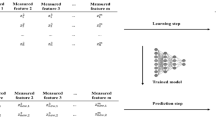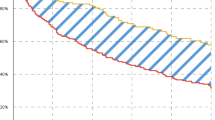Abstract
According to N. Goodman, the Carnapian notion of similarity is useless in science and without interest for philosophy. In our paper we suggest that, given the current role that the notion of similarity has in managing biomedical big data, this drastic position should be revised, and similarity should be provided a scientifically useful philosophical interpretation. With the advent of the new sequencing technologies, imaging technologies and with the improvements of health records, the number of genomics, post-genomics and clinical data has exponentially increased. The deluge of data has urged, among others, to devise a new way of stratifying patients. A solution has been found and it is based exactly on the notion of similarity. By discussing two examples focusing on similarity among breast cancer patients, in the paper we illustrate such a use, and analyze it from a philosophical standpoint by resorting to A. Tversky’s features matching approach. We believe that the latter can foster some better understanding of the meaning and current use of similarity in the context of biomedical big data, and that, therefore, be the focus of further reflections in the philosophy of science, in particular in the philosophy of biomedicine.





Similar content being viewed by others
Notes
It is worth recalling that the similarity notion based on the metric came out in geometry around 1906, thanks to the work of the French mathematicians René Fréchet (even if the name is due to Felix Hausdorff) when he discussed the notion of distance between two points of a topological space. Carnap’s work was very close to the dawn of the mathematical birth of that notion.
We do not discuss here the limits and the potentialities of precision medicine, in particular if precision medicine is really precise or if it is always ethically praiseworthy (both at individual and global level). We do not even face the question whether a more proper definition of precision medicine exists, or which its historical roots are. This is not the right place to face these issues. For our sake, however, we pragmatically accept the well-known definition offered by the US National Research Council, according to which “precision medicine is ‘an emerging approach for disease treatment and prevention that takes into account individual variability in genes, environment, and lifestyle for each person’, [meant] […] to predict more accurately which treatment and prevention strategies for a particular disease will work in which groups of people”: https://ghr.nlm.nih.gov/ Precision Medicine; on the relations between precision and personalized medicine, https://ghr.nlm.nih.gov/primer/precisionmedicine/precisionvspersonalized. See also https://www.nih.gov/research-training/allofus-research-program (Accessed 30 April 2017). See Barilan, Brusa and Ciechanover 2021.
PAM50 Prosigna® is a tumour-profiling test that helps determine the benefit of using chemotherapy in addition to hormone therapy for some estrogen receptor-positive (ER-positive) and HER2-negative breast cancers.
A tumour is said to have had a pCR if, after surgery, no residual cancer cells remain.
For a more technical approach, see Zhu et al. (2016).
This is also the reason why here the distance can be negative, while one of the conditions in the original metric space introduced in geometry and discussed by Carnap was that it has to be positive: a statistical space realized with biomedical data is different from an abstract topological space endowed with a metric.
Due to space limits, we do not show here that also the independence conditions is satisfied.
For other philosophical applications of the FMA, and, specifically, on using similarity for vagueness and identity, see Douven and Decock (2011).
References
Ali, R. H., Rueda, O., Chin, S.-F., et al. (2014). Genome-driven integrated classification of breast cancer validated in over 7,500 samples. Genome Biology, 15, 431.
Barilan, M. Y., Brusa, M., & Ciechanover, A. (Eds.). (2021). Can precision medicine be personal: Can personalized medicine be precise? Oxford: Oxford University Press.
Boniolo, G. (2017). Patchwork narratives for tumour heterogeneity. In H. Leitgeb, I. Niiniluoto, E. Sober, & P. Seppälä (Eds.), Logic, methodology and philosophy of science—Proceedings of the 15th international congress (pp. 311–24). London: College Publications.
Boniolo, G., & Nathan, M. J. (Eds.). (2017). Philosophy of molecular medicine. London: Routledge.
Brown, S.-A. (2016). Patient similarity: Emerging concepts in systems and precision medicine. Frontiers in Physiology, 7, 561. https://doi.org/10.3389/fphys.2016.00561
Bruna, A., Rueda, O. M., Greenwood, W., et al. (2016). A biobank of breast cancer explants with preserved intra-tumor heterogeneity to screen anticancer compounds. Cell, 167, 260–274.
Carnap, R. (1928). Der logische Aufbau der Welt. Berlin: Weltkreisverlag. Repr. Hamburg: Meiner [1961] (and later). English translation by Rolf A. George: The Logical Construction of the World, London: Routledge and Kegan Paul [1967].
Carrara, M., & Morato, V. (2011). Toward a Formal Account of Similarity and Family Resemblance for Technical Functions. In P. E. Vermaas & V. Dignum (Eds.), Formal ontologies meet industry (pp. 63–74). Amsterdam: IOS Press.
Curtis, C., Shah, S., Chin, S.-F., et al. (2012). The genomic and transcriptomic architecture of 2,000 breast tumours reveals novel subgroups. Nature, 486, 346–52.
Dai, L., Zhu, H., & Liu, D. (2020). Patient similarity: methods and applications. arXiv:2012.01976 [cs.LG].
Decock, L., & Douven, I. (2011). Similarity after Goodman. Review of Philosophy and Psychology, 2, 61–75.
Fuller, J., & Flores, L. J. (2015). The risk GP model: The standard model of prediction in medicine. Studies in History and Philosophy of Biological and Biomedical. Sciences, 54, 49–61.
Gärdenfors, P. (2004). Conceptual spaces: The geometry of thought. MIT Press.
Goodman, N. (1972). Seven strictures on similarity. In N. Goodman (Ed.), Problems and projects (pp. 437–446). Indianapolis/New York: Bobbs-Merrill.
Guinney, J., Dienstmann, R., Wang, X., et al. (2015). The consensus molecular subtypes of colorectal cancer. Nature Medicine, 21, 1350–1416.
Leonelli, S. (2016). Data-centric biology: A philosophical study. Chicago, IL: The University of Chicago Press.
Morganella, S., Alexandrov, L. B., Glodzik, D., et al. (2016). The topography of mutational processes in breast cancer genomes. Nature Communications, 7, 11383.
Network, C. G. A. (2015). Genomic classification of cutaneous melanoma. Cell, 16, 1681–1696. https://doi.org/10.1016/j.cell.2015.05.044
Nik-Zainal, S., Van Loo, P., Wedge, D. C., et al. (2012). The life history of 21 breast cancers. Cell, 149, 994–1007.
Nik-Zainal, S., Davies, H., Staaf, J., et al. (2016). Landscape of somatic mutations in 560 Bbreast cancer whole-genome sequences. Nature, 534, 47–54.
Pai, S., & Bader, G. D. (2018). Patient similarity networks for precision medicine. Journal of Molecular Biology. https://doi.org/10.1016/j.jmb.2018.05.037
Parimbelli, E., Marini, S., Sacchi, L., & Bellazzi, R. (2018). Patient similarity for precision medicine: A systematic review. Journal of Biomedical Informatics. https://doi.org/10.1016/j.jbi.2018.06.001
Pereira, B., Chin, S.-F., Rueda, O. M., et al. (2016). The somatic mutation profiles of 2,433 breast cancers refine their genomic and transcriptomic landscapes. Nature Communications, 7, 11479. https://doi.org/10.1038/ncomms11479
Robertson, G. A., Kim, J., Al-Ahmadie, H., et al. (2017). Comprehensive molecular characterization of muscle-invasive bladder cancer. Cell, 171, 540-556.e25.
Ross-Adams, H., et al. (2015). Integration of copy number and transcriptomics provides risk stratification in prostate cancer: A discovery and validation cohort study. eBioMedicine, 2, 1133–1144.
Russnes, H. G., Lingjærde, O. C., Anne-LiseBørresen-Dale, A. L., Caldas, C., et al. (2017). Breast cancer molecular stratification: From intrinsic subtypes to integrative clusters. American Journal of Pathology, 187, 2152–2162.
Sánchez-Valle, J., et al. (2020). Interpreting molecular similarity between patients as a determinant of disease comorbidity relationships. Nature Communications, 11, 2854. https://doi.org/10.1038/s41467-020-16540-x
Slater, M. (2013). Are species real? An essay in the metaphysics of science. Basingstoke: Palgrave MacMillan.
Slater, M. (2015). Natural kindness. The British Journal of Philosophy of Science, 66, 375–411.
Strasser, B. (2019). Collecting experiments: Making big data biology. Chicago, IL: The University of Chicago Press.
Tan, P.-N., et al. (2017). Introduction to data mining (2nd ed.). Reading: Addison-Wesley.
Tversky, A. (1977). Features of similarity. Psychological Review, 84(4), 327–352.
Wallmann, C. (2017). A Bayesian solution to the conflict of narrowness and precision in direct inference. Journal for General Philosophy of Science, 48, 485–500.
Wallmann, C., & Williamson, J. (2017). Four approaches to the reference class problem. In G. Hofer-Szabó & L. Wroński (Eds.), Making it formally explicit: probability, causality and indeterminism (pp. 61–81). Dordrecht: Springer.
Weddell, N., Pajic, M., Patch, A.-M., et al. (2015). Whole genomes redefine the mutational landscape of pancreatic cancer. Nature, 518(26), 495–501.
Zhu, Z., et al. (2016). Measuring patient similarities via a deep architecture with medical concept embedding. In 2016 IEEE 16th international conference on data mining. https://doi.org/10.1109/ICDM.2016.0086.
Acknowledgements
We wish to thank the referees of Erkenntnis for their comments and suggestions on preliminary versions of the paper.
Author information
Authors and Affiliations
Corresponding author
Additional information
Publisher's Note
Springer Nature remains neutral with regard to jurisdictional claims in published maps and institutional affiliations.
Rights and permissions
About this article
Cite this article
Boniolo, G., Campaner, R. & Carrara, M. Patient Similarity in the Era of Precision Medicine: A Philosophical Analysis. Erkenn 88, 2911–2932 (2023). https://doi.org/10.1007/s10670-021-00483-w
Received:
Accepted:
Published:
Issue Date:
DOI: https://doi.org/10.1007/s10670-021-00483-w




